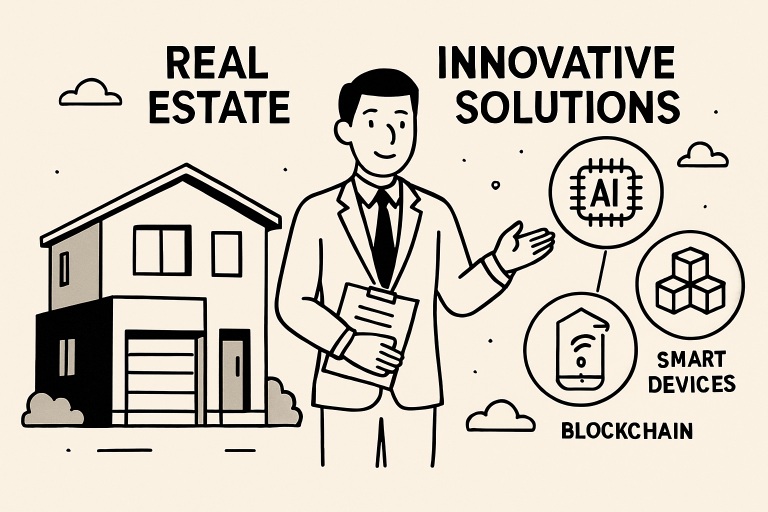In the ever-evolving world of real estate, today’s professionals face unprecedented challenges. Market volatility, supply chain disruptions, shifting buyer preferences, and economic uncertainties are putting pressure on industry players to rethink their strategies. Real estate agents, investors, and developers must harness innovative tools and approaches tailored to this dynamic landscape to stay competitive and resilient. If you’re navigating Colorado’s complex property laws, partnering with the best real estate lawyers in Colorado can offer an added layer of expertise and protection as you pursue these creative solutions.
Adapting to these changes also means embracing next-generation technologies and alternative business models. From Artificial Intelligence (AI) transforming property evaluation to blockchain enabling unprecedented transaction transparency, new innovations are no longer optional—they’re essential. Additionally, creative financing and building methods are helping buyers and sellers find opportunities in an unpredictable market. Modern professionals who implement these strategies are not just surviving—they’re thriving in this challenging era.
Leveraging Artificial Intelligence in Real Estate
AI-powered solutions have redefined efficiency in real estate. Today, AI algorithms can analyze millions of property data points in seconds, providing accurate market trend predictions and automated valuations. These tools help real estate professionals make better-informed choices while minimizing the risk of human error. AI-driven chatbots and virtual assistants handle routine inquiries, manage appointments, and guide potential buyers through listings, freeing up valuable time for agents to nurture client relationships and negotiate deals.
Some agencies are using AI to assess neighborhoods and estimate future property values by evaluating economic trends and local development plans. As Forbes reported, these advancements are transforming decision-making and client engagement in the sector.

Blockchain for Transparent Transactions
Traditional real estate transactions are often laden with paperwork and middlemen, which can slow down processes and introduce the risk of fraud. Blockchain technology addresses these pain points with a secure, decentralized ledger for property transactions. By tokenizing physical assets, blockchain makes it possible to facilitate fractional ownership, offering broader access to investment opportunities and lower barriers to entry. At the same time, it can dramatically reduce the costs and time associated with closing deals.
This revolution in transactional transparency also mitigates risk; once recorded, transactions on a blockchain are permanent and cannot be altered, thereby building trust for all parties involved. Industry experts at The Wall Street Journal note that while widespread adoption is still emerging, early use cases are already cutting down on fraud and administrative costs.
Creative Financing Amid Economic Uncertainty
Interest rate hikes and persistent inflation have made conventional loans less appealing or unattainable for many buyers. Real estate professionals and consumers are turning to creative financing options to overcome these hurdles. “Buy Before You Sell” programs allow homeowners to purchase their next home before they’ve closed on their current one, bridging financial gaps and smoothing transactions. Meanwhile, mortgage rate buy-downs—where sellers or builders pay a portion of a buyer’s interest payments upfront to secure a lower rate for the first few years—are resurgent.
In addition, lease-to-own agreements and seller financing arrangements are gaining popularity, giving buyers with limited means new ways to enter the market. By offering more flexibility, these options help sustain demand and maintain liquidity even during turbulent periods.
Repurposing Existing Structures
With an increasing shortage of affordable housing and the ongoing shift away from traditional retail and office spaces, developers are getting creative with adaptive reuse. Vacant malls, hotels, and office buildings are now transformed into residential units. This approach enables cities to address critical housing shortfalls without the environmental impact and lengthy approval processes of ground-up construction.
Not only does repurposing foster community revitalization, but it also drives sustainability by reusing resources and infrastructure. Cities like Denver and Los Angeles have piloted successful conversions, breathing new life into dormant downtown districts while meeting urgent housing needs.
Embracing Modular and Prefabricated Housing
Modular construction and prefabricated homes present viable solutions for delivering housing at scale, efficiently, and affordably. By manufacturing components in controlled environments and assembling them on-site, builders can cut down on construction time and minimize the impact of weather or supply chain delays. These methods are invaluable in regions with pressing housing shortages or recovery needs after natural disasters.
Furthermore, modern design innovations in prefab housing now offer a range of options—from luxury residences to efficient, affordable units—that can be tailored for both urban and rural developments. According to The New York Times, investment in such methods continues accelerating as governments and private stakeholders seek scalable housing solutions.
Integrating Smart Technologies
As homebuyers grow savvier, the demand for integrated innovative technologies has become a significant market driver. Features like smart thermostats, automated lighting and security systems, and advanced energy management tools set listings apart while cutting down on utility costs. IoT-enabled devices make it easier for property managers to monitor maintenance needs and optimize building performance remotely.
Innovative technology not only satisfies the expectations of today’s tech-forward consumers but also contributes to sustainability targets. Green-certified homes with efficient appliances and monitoring systems command higher resale values and help reduce the overall environmental footprint.
Conclusion
The future of real estate depends on embracing innovation, flexibility, and forward-thinking strategies to navigate an ever-changing market. Professionals are integrating cutting-edge technologies such as artificial intelligence, data analytics, and virtual reality to enhance decision-making and property experiences. At the same time, creative financing options and the repurposing of underused properties are reshaping how value is created and sustained. These adaptive approaches allow stakeholders to respond effectively to shifting economic conditions, sustainability demands, and evolving buyer preferences. Whether you’re a seasoned investor seeking growth or a first-time buyer pursuing stability, these strategies provide tools to uncover hidden potential, reduce exposure to risks, and strengthen long-term success—ultimately supporting the development of dynamic, resilient communities built to thrive in an increasingly complex real estate landscape.
